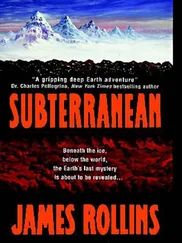The Russians had bound them after Jenny and the seaman had escaped, keeping them under constant armed guard. Then a few moments ago, the Russians had fled. It was clear from their hurried departure and frantic grab for supplies that they were abandoning the base.
But why? Had they discovered what they came to find? And what was to be their own fate? These questions had been bandied about, mostly among the civilian scientists. But John had seen the answer in Lieutenant Commander Sewell’s eyes. He had overheard the conversation about the V-class incendiary bombs planted throughout the drift station. There was no doubt what was going to happen, what the Russians intended.
Then the blasts had started, rocking the ice, deafening even the storm.
“Everyone stay calm!” Sewell yelled in a firm authoritative voice. His attempt at assuredness was weakened as he almost lost his footing with another rattle of ice. He caught himself on one of the bed frames. “Panic will not help us escape!”
John continued to sit, unconcerned. Jenny had escaped. He had heard the Twin Otter buzz by overhead. John positioned his feet closer to the space heater.
At least he’d die warm.
3:04 P.M.
OUTSIDE OMEGA DRIFT STATION
Master Sergeant Kanter lay on the far side of a steep pressure ridge. The rocket launcher he had used to pierce the sub was propped beside him, but it was no longer needed. His ears ached from the concussion blows of the depth charges. Even though he was half shielded by the ridgeline, the explosions felt like punches to his solar plexus. Each one pounded at him.
He watched drum after drum drop into the sea, sink the preset ten feet, and blow. Water ballooned up, then exploded skyward, casting a funnel of water and ice high into the air. The float ice under Kanter bucked with each blow.
The wide lake of the polynya had turned into a roiling and hellish pool. Fires burned onshore. The edges of the lake were shattered. Steam flowed into the snowy blizzard, masking and shrouding the bulk of the sinking submarine. It foundered in the lake, vertical in the water, only its nose visible — and even this was sinking rapidly.
Kanter spotted a pair of Russian sailors bob up in the lake, struggling to keep their heads above water. They wore orange float suits. Evacuees, attempting to escape. It did them no good. A depth charge landed a yard from them. It blew, casting their shattered and broken forms through the air to smash against both ice and their own boat.
There would be no escape.
Farther out, the Sikorsky helibus circled the hovering Seahawk. It had dropped the remaining team members and awaited further orders. Somewhere Delta One was organizing ground forces to retake the U.S. research base.
But Kanter’s attention remained on the polynya.
The majesty of the attack was breathtaking, a symphony of ice, fire, water, and smoke. He felt each explosion down to his bones, becoming a physical part of the attack himself.
Kanter had never been prouder than at this moment.
Then he spotted movement on the flank of the dying sub.
3:06 P.M.
ABOARD THE DRAKON
Mikovsky was strapped in a seat, as were most of the key bridge crew, trying to keep some semblance of order. Their boat was dead: compartments crushed, flooding everywhere, engines almost gone. Smoke choked through the bridge, making it difficult to think, to see. The explosions deafened them. The bridge crew wore emergency air-breathing masks, but such meager safety devices would not save them — only allow them one last act of revenge.
“Message relayed through digital shortwave!” the radioman yelled from the neighboring communication shack, half his face burned by an electrical fire he had managed to put out. His words sounded as if they came from down a long tunnel, hollow and whispery.
Mikovsky glanced to his weapons officer. He got the nod he wanted. They could not carry on proper protocol, but communication was still intact. His weapons officer confirmed the fire control solution and target fix — one unlike any calculated before.
Their vessel might be doomed, but they weren’t dead.
The Drakon carried a full complement of two-hundred-knot Shkval torpedoes, SS-N-16 antisubmarine missiles, and one pair of UGST rocket torpedoes. This last pair were the latest in Russian design, powered by a liquid monopropellant with its own oxidizer. They were mounted in special flank tubes that deployed by pushing out from the sides of the boat. It had been an accident in such a deployment that had led to the Kursk tragedy back in 2000, a mishandling that led to the loss of all aboard.
There was no mishandling today.
He got the nod that the starboard UGST rocket tube was flooded and ready, target locked. All that remained was one word from him.
The last word he would ever speak.
“Fire!”
3:07 P.M.
USS POLAR SENTINEL
“I’m reading a weapons launch!” the sonar chief yelled, jerking to his feet. “Torpedo in the water!”
Perry started toward the man. “Target?”
The Polar Sentinel was in full retreat from the hot zone. The bombardment of depth charges threatened his own boat. The cap of ice overhead trapped the concussive waves from the explosions, radiating them outward under the ice. Like dropping a cherry bomb down a toilet.
But as the Sentinel fled, Perry kept tabs on the Russian sub. He was taking no chances.
“Target does not appear to be us,” the sonar chief said.
“Then who?”
3:07 P.M.
OUTSIDE OMEGA DRIFT STATION
Frantic, Master Sergeant Kanter tried to raise Delta One. He needed to get the warning out.
“Delta One, here.”
Kanter still wore his subvocal microphone — where the barest whisper could be heard — but now he yelled. “Sir, you have to tell the Seahawk—”
He was too late. From his vantage on top of the ice ridge, Kanter saw a blast of fire ignite below the churning waterline of the foundering submarine. From the flank side of its drowned bulk, a lance of gray metal burst out of the water, leaping into the air.
The missile rocketed skyward, aimed dead center on the Seahawk helicopter hovering overhead. It was impossible for the craft to get out of the way in time.
“Christ!” Delta One screamed in his ear, spotting the danger.
The torpedo struck the helicopter. It seemed for a moment to spear completely through the Seahawk, an arrow piercing its target.
Kanter held his breath.
Then the rotors slammed into the thrusted tip of the torpedo rocket. The blast — accentuated by the two remaining depth-charge drums still attached to the helicopter’s undercarriage — shattered outward in a ball of metal and flame.
Kanter dove behind his ridgeline, seeking shelter from the rain of oil and steel, covering his head. Through the noise of the explosion, he heard the telltale whup-whup of another chopper.
He glanced back over a shoulder.
The remaining helicopter, the Sikorsky helibus, raced overhead. Kanter saw it pelted with flaming debris, cutting right through the craft. A section of the Seahawk’s broken rotor flipped end over end and crashed into the forward crew cabin. The helibus lurched over on its side, its blades chopping vertically at the air.
Kanter struggled to his feet, but the slick ice and blowing winds betrayed him. He fell. He fought again, fingers digging at the sharp ice. The toes of his boots fought for purchase.
He snapped a look up. The helibus plummeted toward him, spinning toward the crash, whipping around and around.
It was impossible to get out of the way in time.
Читать дальше










